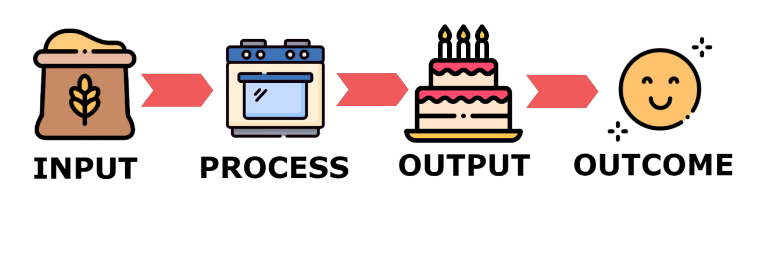Thinking in business terms, here’s how we can define these two terms: The outcomes are what the business wants or needs to achieve. The outputs are the actions or items that contribute to achieving an outcome. An easy way to think of this is that outcomes are the results, and outputs are the activities that support the desired results. For example, a business outcome could be ‘increased customer satisfaction’. An output that can help achieve this might be a responsive online ordering system.
What are the differences between an outcome and an output?
The differences between the two terms are particularly important when using them within our market research. Let’s look at an example of what could be an outcome vs an output: An outcome is what our customers want. For example, increasing customer satisfaction. An output is the action (or item) that contributes to the customer achieving their desired outcome. For example, an adaptive online ordering system. The role of the outcome is to achieve the customer’s desired outcome (hence the word ‘outcome’). The role of the output is to ensure the outcome is achieved.
The importance of focusing on outcomes
Businesses create new products and services all the time. While creating the product or service is clearly important, what’s much more important is what results you get from it. In other words, the impact it has on customers and/or the market. Making something into a product or service does provide a certain benefit. But is that the only benefit? When we talk about impact, we’re not talking about mere financial value, or a subjective feeling of “feeling good” about ourselves. We’re talking about measurable improvements to something. You can measure whether or not something has increased customer satisfaction, increased sales, or decreased costs, for example.
Key factor to a business
The key factor to a business is whether they’re able to achieve the outcomes. You can do all the best work in the world but if you don’t have the ability to achieve the desired outcomes, you’ll never get to achieve your goal. The outputs in a business are the things that help achieve the business outcomes. A good example is the outputs of a tech start-up that wanted to drive customer growth. They could build a great website and attract customers, but this alone wouldn’t help them achieve their goal of increasing customer growth. They also needed to connect with them and close the sale in a way that was meaningful.
Does measuring outputs help or hinder the outcome?
With outputs, there are a couple of things to note. There is no competition between outcomes and outputs, so they both go towards the same thing. This is important because most outputs are not tightly defined. An input that helps to reach the desired outcome might seem insignificant, but may not actually be crucial if it is not captured in the outcome document. If you measure outputs, you must include them in the outcome document, or risk looking less important, so there’s no incentive for people to improve your output. A measuring mechanism with no visibility makes the outputs less important because they’re not included in the outcome document, and people will forget about them, not noticing if they improved. On the other hand, measuring outputs can create the same issue.
Conclusion
I’m sure you’ve got the message now. Too many businesses think that having the best outcome is all that matters. As they say, actions speak louder than words. In reality, in order to achieve the best outcomes, business needs to create and embrace the best outcomes themselves. And yes, actions speak louder than words. For this reason, ‘mindset’ is a key area in which businesses need to improve. They need to change how they are thinking about their products or services in order to drive their business objectives. What do you think? Let me know in the comments below.

Leave a Reply